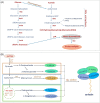Biotechnological potential of microbial bio-surfactants, their significance, and diverse applications
- PMID: 37614639
- PMCID: PMC10442721
- DOI: 10.1093/femsmc/xtad015
Biotechnological potential of microbial bio-surfactants, their significance, and diverse applications
Abstract
Globally, there is a huge demand for chemically available surfactants in many industries, irrespective of their detrimental impact on the environment. Naturally occurring green sustainable substances have been proven to be the best alternative for reducing reliance on chemical surfactants and promoting long-lasting sustainable development. The most frequently utilized green active biosurfactants, which are made by bacteria, yeast, and fungi, are discussed in this review. These biosurfactants are commonly originated from contaminated sites, the marine ecosystem, and the natural environment, and it holds great potential for environmental sustainability. In this review, we described the importance of biosurfactants for the environment, including their biodegradability, low toxicity, environmental compatibility, and stability at a wide pH range. In this review, we have also described the various techniques that have been utilized to characterize and screen the generation of microbial biosurfactants. Also, we reviewed the potential of biosurfactants and its emerging applications in the foods, cosmetics, pharmaceuticals, and agricultural industries. In addition, we also discussed the ways to overcome problems with expensive costs such as low-cost substrate media formulation, gravitational techniques, and solvent-free foam fractionation for extraction that could be employed during biosurfactant production on a larger scale.
Keywords: biodegradability; bioremediation; biosurfactants; eco-friendly; emulsifying agent; toxicity.
© The Author(s) 2023. Published by Oxford University Press on behalf of FEMS.
Conflict of interest statement
The authors declare no competing interests.
Figures



Similar articles
-
Microbial surfactants: characteristics, production and broader application prospects in environment and industry.Prep Biochem Biotechnol. 2023 Oct;53(9):1013-1042. doi: 10.1080/10826068.2023.2175364. Epub 2023 Aug 31. Prep Biochem Biotechnol. 2023. PMID: 37651735
-
Biosurfactant: A new frontier for greener technology and environmental sustainability.Ecotoxicol Environ Saf. 2019 Nov 30;184:109607. doi: 10.1016/j.ecoenv.2019.109607. Epub 2019 Sep 7. Ecotoxicol Environ Saf. 2019. PMID: 31505408 Review.
-
Microbial Surfactants: The Next Generation Multifunctional Biomolecules for Applications in the Petroleum Industry and Its Associated Environmental Remediation.Microorganisms. 2019 Nov 19;7(11):581. doi: 10.3390/microorganisms7110581. Microorganisms. 2019. PMID: 31752381 Free PMC article. Review.
-
Microbial biosurfactants: Green alternatives and sustainable solution for augmenting pesticide remediation and management of organic waste.Curr Res Microb Sci. 2024 Aug 13;7:100266. doi: 10.1016/j.crmicr.2024.100266. eCollection 2024. Curr Res Microb Sci. 2024. PMID: 39257939 Free PMC article. Review.
-
Sustainable biosurfactant produced by Serratia marcescens UCP 1549 and its suitability for agricultural and marine bioremediation applications.Microb Cell Fact. 2019 Jan 4;18(1):2. doi: 10.1186/s12934-018-1046-0. Microb Cell Fact. 2019. PMID: 30609918 Free PMC article. Review.
Cited by
-
Editorial: thematic issue on modulating the environment with microbes.FEMS Microbes. 2024 Jul 27;5:xtae021. doi: 10.1093/femsmc/xtae021. eCollection 2024. FEMS Microbes. 2024. PMID: 39070771 Free PMC article.
-
Advancements in biosurfactant production using agro-industrial waste for industrial and environmental applications.Front Microbiol. 2024 Feb 5;15:1357302. doi: 10.3389/fmicb.2024.1357302. eCollection 2024. Front Microbiol. 2024. PMID: 38374917 Free PMC article. Review.
-
Unveiling the antimicrobial and antibiofilm potential of biosurfactant produced by newly isolated Lactiplantibacillus plantarum strain 1625.Front Microbiol. 2024 Sep 10;15:1459388. doi: 10.3389/fmicb.2024.1459388. eCollection 2024. Front Microbiol. 2024. PMID: 39318434 Free PMC article.
-
Biotechnological Utilization of Agro-Industrial Residues and By-Products-Sustainable Production of Biosurfactants.Foods. 2024 Feb 26;13(5):711. doi: 10.3390/foods13050711. Foods. 2024. PMID: 38472824 Free PMC article. Review.
References
-
- Ahn C, Morya VK, Kim EK. Tuning surface-active properties of bio-surfactant sophorolipids by varying fatty-acid chain lengths. Korean J Chem Eng. 2016;33:2127–33.
-
- Alvarez VM, Jurelevicius D, Marques JMet al. . Bacillus amyloliquefaciens TSBSO 3.8, a biosurfactant-producing strain with biotechnological potential for microbial enhanced oil recovery. Colloids Surf B. 2015;136:14–21. - PubMed
Publication types
LinkOut - more resources
Full Text Sources
